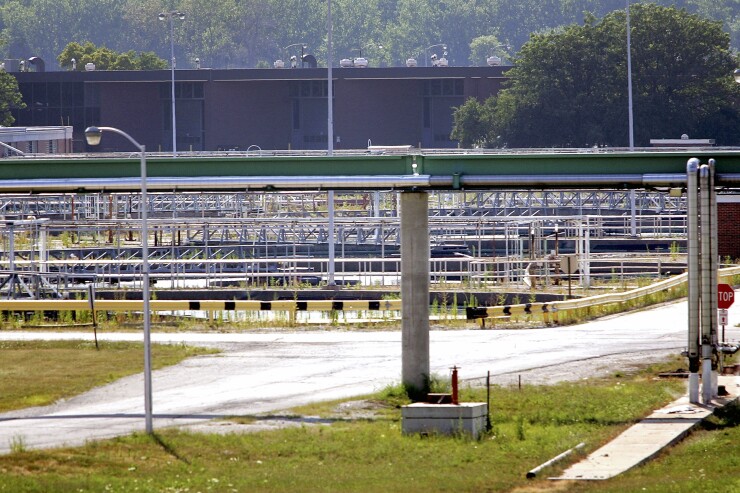The Metropolitan Water Reclamation District of Greater Chicago returns to the market this week after a five-year absence with a $500 million general obligation deal that offers some of the highest-grade local debt with a Chicago name.
The Chicago name — despite the water reclamation district's lack of ties to the city and governance by its own elected board — offers investors a yield kick but heightened attention on infrastructure-related bonds also could help rein in some penalties.
The district, which manages waste- and stormwater in the Chicago region, will offer six series including two new money series self-designated as green bonds totaling $141 million with the other $359 million refunding debt in two tax-exempt and two taxable tranches.

JPMorgan is running the books and Loop Capital Markets LLC is co-senior manager.
Ahead of this deal, Fitch Ratings affirmed the district’s AAA rating and S&P Global Ratings affirmed its AA rating after hitting the district with a one-notch downgrade last year over its pension burden.
The district last publicly sold debt in 2016 – a portion of which carried a self-designed green label – and has since relied on the state revolving fund to cover capital needs. The Illinois Environmental Protection Agency manages the loan program and the Illinois Finance Authority borrows to finance loans.
“The district is fortunate to receive low interest cost loans from the IEPA to fund many of its capital projects for the past several years. Approximately $70 million of loans are bonded each year,” said MWRD Treasurer Mary Ann Boyle.
The refunding will shorten the average life of the bonds and smooth annual debt service with $154 million of cash flow savings expected and $114 million of net present value savings over the repayment life.
“Although debt service increases incrementally in certain years, debt capacity is increased and overall present value savings are projected to be substantial,” Fitch Ratings said of the refunding plans. “The district has also budgeted for the prepayment of certain outstanding State Revolving Fund loans providing additional debt service savings.”
New money proceeds will help pay for the five-year, $787 million capital program that relies on a total of $633 million of direct and SRF district borrowing with other funding coming from the Army Corps of Engineers and stormwater management fund tax levy collections. Projects include the deep tunnel known as the Tunnel and Reservoir Plan that’s designed to capture storm water and prevent flooding, bio-solids management, facility upgrades, and intercepting sewers.
“In our view, these very high quality bonds can be a core holding of most municipal bond portfolios,” CreditSights wrote in its weekly market preview authored by John Ceffalio, senior municipal research analyst, and Patrick Luby, senior municipal strategist.
“Unless the market truly shifts to a ‘risk off’ mentality that concentrates demand into higher-grade bonds, we do not envision that spreads could tighten materially — but at spreads that are a little wider than for many high grades, MWRD bonds could provide a slight boost for income,” CreditSights said. MWRD bonds have traded at about a 27 basis point spread to the AAA index. That’s about 11 bps wider than a broader local GO index.
"Given the market appetite for infrastructure-related investments, demand for the taxable bonds could result in spreads tighter than the benchmark levels," CreditSights said.
The district operates on a roughly $375 million budget with property taxes its largest revenue source. Reserves and liquidity remain in healthy shape and the COVID-19 pandemic had little impact, but its pension burden weighs on ratings, as they do on the state and many local governments across Illinois, despite progress made in recent years. The district is carrying $1.1 billion of unfunded liabilities with a funded ratio of 58.5%.
With airtight constitutional protections against benefit cuts, MWRD took early steps ahead of most in 2013 to begin addressing the pension and other post-employment retiree healthcare strains with increased funding contributions and setting up an OPEB trust.
The district’s proposed 2022 budget sends an additional $30 million to supplement the statutory contribution.
“Effective January 1, 2022, the district may make revenue transfers in addition to interest income. As a result, a $30 million advance funding contribution is planned in the 2022 budget which is in addition to the maximum funding amount allowed by the policy,” Boyle said.
The supplemental contributions bring the payment to an amount above an annual determined contribution and while they must be approved annually the goal is to maintain them to reach a 100% funded ratio in 2050.
The OPEB trust fund is expected to be fully funded by 2026.
“The rating reflects our view of MWRD's moderate debt burden and limited future debt needs," said S&P analyst Helen Samuelson. "The rating further reflects MWRD's good incomes and its participation in the deep and diverse Chicago metropolitan area economy."
The district continues to have a significant unfunded pension liability, Fitch said. “However, annual costs (approximately $133 million in 2020) are manageable in the context of overall district operations and considering the separate levy.”
The district has about $687 million of unlimited tax GOs and $1.1 billion of limited tax GOs. The district’s coverage area encompasses 5.2 million residents and spans 128 suburbs beyond Chicago’s borders.
Correction: Patrick Luby is a CreditSights strategist. His first name was incorrect in the original version of this story.





